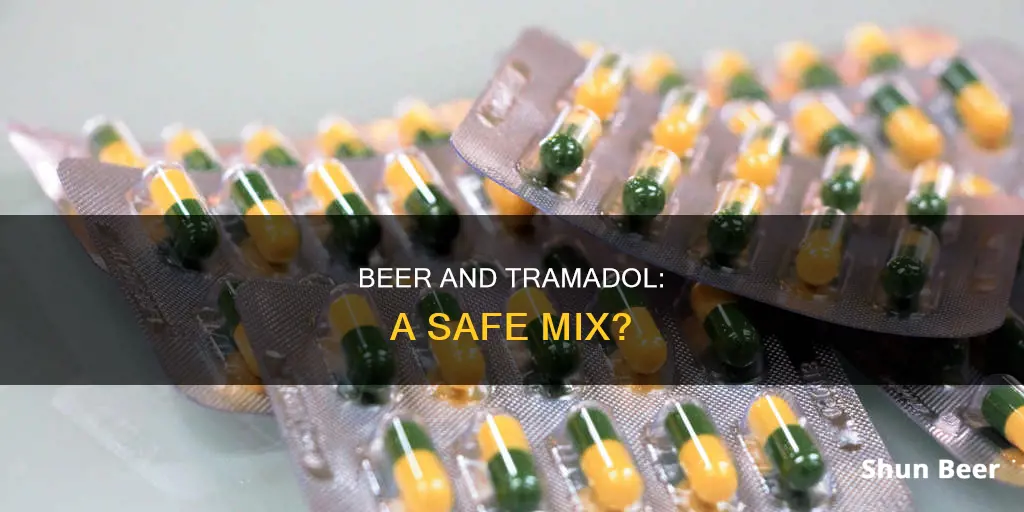
Tramadol is a prescription opioid painkiller that is often prescribed to treat moderate to severe pain. It is a central nervous system depressant, which means it can slow down brain function. Alcohol is also a central nervous system depressant, and when mixed with tramadol, the effects of both substances are intensified, increasing the risk of psychosis, anxiety, delusions, mania, paranoia, and addiction. Mixing the two can also lead to respiratory depression, unconsciousness, coma, and even death. Therefore, it is not recommended to drink alcohol while taking tramadol.
| Characteristics | Values |
|---|---|
| Should you drink beer while taking tramafol? | No |
| Why? | Both substances depress the central nervous system, increasing the risk of psychosis, anxiety, delusions, mania, paranoia, and serotonin syndrome. |
| What are the dangers? | Intensified sedative and respiratory depressing effects, unconsciousness, coma, respiratory arrest, overdose, or death. |
| How long after taking tramadol can I drink alcohol? | It is recommended to wait until the tramadol is completely out of your system, which can take around 32 hours for short-acting tramadol and 50 hours for long-acting tramadol. |
What You'll Learn
- Tramadol and alcohol are both central nervous system depressants, which can lead to respiratory depression and slowed breathing
- Combining the two substances can increase the risk of psychosis, anxiety, delusions, mania, paranoia, and cognitive impairment
- The risk of a fatal overdose is increased when tramadol is consumed with alcohol
- Mixing tramadol and alcohol can cause liver damage, circulatory problems, memory loss, hallucinations, and convulsions
- There is a higher risk of addiction when consuming alcohol with tramadol

Tramadol and alcohol are both central nervous system depressants, which can lead to respiratory depression and slowed breathing
Tramadol is a medication prescribed to treat moderate to severe pain, as well as chronic pain when other pain relievers are no longer effective. It is an opioid that works by blocking pain signals that travel along the nerves to the brain.
Alcohol, on the other hand, is a central nervous system depressant that stimulates the inhibitory neurotransmitter GABA (Gamma-Aminobutyric Acid). This stimulation dampens brain activity and reduces anxiety.
When taken together, tramadol and alcohol can have dangerous consequences. Both substances are central nervous system depressants, which means they can slow down brain function when combined. This interaction can lead to a range of side effects, including problems with concentration, cognitive impairment, impaired judgment, and coordination difficulties. More severely, the combination can cause respiratory depression, leading to slowed or stopped breathing. In extreme cases, this can result in coma, respiratory arrest, and even death.
The risk of a fatal overdose also increases when tramadol is mixed with alcohol. This is because the effects of both substances are intensified, increasing the likelihood of additive side effects and overdose. Additionally, alcohol can trigger the rapid release of tramadol in the body, especially if it is the extended-release formulation, further heightening the risk of overdose.
The combination of tramadol and alcohol can also lead to an increased risk of addiction and long-term organ damage, including liver, kidney, and brain damage. It is crucial to avoid alcohol consumption entirely while taking tramadol to prevent these dangerous health complications.
Beer and Health: A Daily Drink, Good or Bad?
You may want to see also

Combining the two substances can increase the risk of psychosis, anxiety, delusions, mania, paranoia, and cognitive impairment
Combining tramadol and alcohol can have severe consequences for your mental health. The mixture can lead to psychosis, anxiety, delusions, mania, paranoia, and cognitive impairment. This is because both substances are central nervous system depressants, which means they can slow down brain function when combined. The interaction between the two substances can lead to additive side effects, increasing the risk of a potentially fatal overdose.
Tramadol is an opioid that acts against certain nerve receptors in the brain, altering the way the brain perceives and responds to pain messages. It is often prescribed to treat moderate to severe pain, particularly in cases of chronic conditions that require long-term treatment. As a central nervous system depressant, it can cause drowsiness and dizziness, even when taken as prescribed.
Alcohol, in its drinking form, ethanol, is made from fermented grains, fruits, or other sugars. It stimulates the inhibitory neurotransmitter GABA (Gamma-Aminobutyric Acid), which dampens brain activity and reduces anxiety. Despite its energizing effect, alcohol is also a central nervous system depressant.
When mixed, tramadol and alcohol have higher or enhanced individual effects, increasing the risk of addiction and overdose. The combination can result in feelings of drowsiness, dizziness, and reduced coordination and judgment. It can impair body movement and thinking ability. Even moderate drinking while taking tramadol can be dangerous, as the risk of a potentially fatal overdose is much higher.
The combination of tramadol and alcohol can also lead to serious physical health problems, including damage to the central nervous system and respiratory depression. This can result in lowered blood pressure, respiratory arrest, unconsciousness, coma, or even death. Additionally, the liver may struggle to process both substances, increasing the risk of severe liver damage.
The abuse of alcohol and tramadol is extremely dangerous and has led to many deaths. It is crucial to avoid alcohol consumption entirely while taking tramadol to prevent life-altering consequences.
Light Beer and Liver Damage: How Much is Too Much?
You may want to see also

The risk of a fatal overdose is increased when tramadol is consumed with alcohol
Tramadol is a prescription opioid used to treat moderate to severe pain. It is a central nervous system depressant, which means it can slow down brain function. When taken with alcohol, another central nervous system depressant, the side effects of both substances are increased. This can lead to problems with concentration, cognitive impairment, impaired judgement, and coordination difficulties.
More seriously, the combination of tramadol and alcohol can cause extreme sedation, respiratory depression (slowed or stopped breathing), coma, and even death. This is because the combination of the two substances intensifies the sedative and respiratory depressing effects of both, which can lead to unconsciousness, coma, respiratory arrest, overdose, or death.
It is important to note that the amount of tramadol it takes to overdose depends on the person's tolerance and genetics. However, the risk of a fatal overdose is always increased when tramadol is consumed with alcohol. If you are taking tramadol, it is safest to wait until it is completely out of your system before consuming alcohol.
Beer Drinking Laws in Alaska: Age Limit Explained
You may want to see also

Mixing tramadol and alcohol can cause liver damage, circulatory problems, memory loss, hallucinations, and convulsions
Tramadol is an opioid pain medication prescribed to treat moderate to severe pain as well as chronic pain when weaker pain relievers are no longer effective. While it has a low potential for dependence compared to other opioids like morphine, dependence can still occur when used for prolonged periods.
Tramadol and alcohol are dangerous when combined because both substances depress the central nervous system. This can intensify the sedative and respiratory depressing effects of both, which could lead to unconsciousness, coma, respiratory arrest, overdose, or death. When opioids are mixed with alcohol and other central nervous system depressants, it can lead to life-threatening respiratory depression, causing severe oxygen deprivation and long-term brain damage. This can quickly result in a coma or become fatal.
Mixing tramadol and alcohol can also cause liver damage, circulatory problems, memory loss, hallucinations, and convulsions. When detoxing from alcohol, withdrawal symptoms may include anxiety, agitation, increased heart rate and blood pressure, vomiting, high body temperature, hallucinations, and seizures. A combined alcohol and opioid dependence can increase the likelihood of a severe or complicated withdrawal.
If you or someone you know is struggling to stop drinking while taking tramadol, it may be time to seek professional help to quit.
Mixing Beer and Liquor: Safe or Not?
You may want to see also

There is a higher risk of addiction when consuming alcohol with tramadol
Tramadol is an opioid that is often prescribed to treat pain. It is considered to have a low risk of dependence and abuse when compared to other opioids like morphine. However, it is still possible to become dependent on and addicted to tramadol, especially with prolonged use. When taken as prescribed, common side effects include nausea, dizziness, and vomiting.
Mixing tramadol and alcohol is dangerous because both substances are central nervous system depressants. This means that they can slow down brain function when combined, leading to intensified sedative and respiratory depressing effects. As a result, drinking alcohol while taking tramadol can increase the risk of unconsciousness, coma, respiratory arrest, overdose, or even death.
The combination of these substances can also worsen central nervous system depressant side effects, including excessive sedation and slowed breathing. In severe cases, this can lead to a coma or death. Additionally, the risk of a fatal overdose is increased when tramadol is used with other central nervous system depressants, including alcohol. Extreme sedation, respiratory depression, coma, and death are all possible consequences.
According to the Diagnostic and Statistical Manual of Mental Disorders (DSM-5), a person must meet at least two of the following criteria within a 12-month period to be diagnosed with an opioid and/or alcohol use disorder:
- Cravings or strong urges to use.
- Developing a tolerance and needing larger amounts or more frequent doses.
- Experiencing withdrawal symptoms when trying to quit.
- An inability to quit or cut back on use.
- Drinking alcohol or taking higher amounts of opioids more frequently than intended.
- Spending a significant amount of time obtaining, using, and recovering from the effects of opioids or alcohol.
- Continuing to use despite psychological or physical problems likely caused by use.
- Continuing use despite recurring interpersonal or social problems due to use.
- Using alcohol or drugs in physically dangerous situations, such as driving.
- Failing to fulfil obligations at work, home, or school due to substance use.
- Stopping recreational, social, or work activities because of substance use.
Given the risks associated with mixing tramadol and alcohol, it is important to seek professional help if you or someone you know is struggling to abstain from alcohol while taking tramadol.
Drinking Beer at Texas Parks: What's Allowed?
You may want to see also







